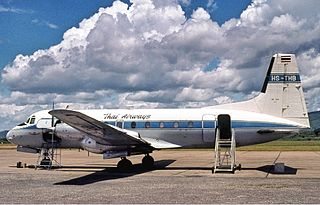Thai Airways Company or Thai Airways was the domestic flag carrier of Thailand. Its main base was the domestic terminal at Don Mueang International Airport. Its head office was located in Pom Prap Sattru Phai, Bangkok. In 1988, Thai Airways merged to become Thai Airways International.

The Hawker Siddeley HS 748 is a medium-sized turboprop airliner originally designed and initially produced by the British aircraft manufacturer Avro. It was the last aircraft to be developed by Avro prior to its absorption into Hawker Siddeley.

The British Aerospace ATP is an airliner designed and produced by British Aerospace. It was an evolution of the Hawker Siddeley HS 748, a fairly successful feederliner of the 1960s.

The British Aerospace 125 is a twinjet mid-size business jet. Originally developed by de Havilland and initially designated as the DH.125 Jet Dragon, it entered production as the Hawker Siddeley HS.125, which was the designation used until 1977. Later on, more recent variants of the type were marketed as the Hawker 800.

The Civil Aviation Authority (CAA) is the statutory corporation which oversees and regulates all aspects of civil aviation in the United Kingdom. Its areas of responsibility include:

Dan-Air was an airline based in the United Kingdom and a wholly owned subsidiary of London-based shipbroking firm Davies and Newman. It was started in 1953 with a single aircraft. Initially, it operated cargo and passenger charter flights from Southend (1953–1955) and Blackbushe airports (1955–1960) using a variety of piston-engined aircraft before moving to a new base at Gatwick Airport in 1960, followed by expansion into inclusive tour (IT) charter flights and all-year round scheduled services. The introduction of two de Havilland Comet series 4 jet aircraft in 1966 made Dan-Air the second British independent airline after British United Airways to begin sustained jet operations.

Bouraq Indonesia Airlines, branded sometimes as Bouraq Airlines or Bouraq, was an airline headquartered in Jakarta, Indonesia, which operated mostly domestic passenger flights out of its bases at Soekarno-Hatta International Airport and Sultan Aji Muhammad Sulaiman Airport.

The Hawker Siddeley HS 780 Andover is a twin-engined turboprop military transport aircraft produced by Hawker Siddeley for the Royal Air Force (RAF), developed from the Avro-designed HS 748 airliner. The Andover was named after the Avro Andover, a biplane transport used by the RAF for medical evacuation between the first and second world wars; and RAF Andover, where some of its trials were carried out. The Andover had a kneeling landing gear to make ramp loading easier.
West Air Sweden, operating as West Atlantic, is a cargo airline based in Malmö, Sweden. It operates scheduled and ad hoc freight charter services for FedEx, DHL and UPS. It is also contracted to operate mail flights for different postal services within Europe. Its main bases are Charles de Gaulle Airport and Oslo Airport, Gardermoen.

Sumburgh Airport is the main airport serving Shetland in Scotland. It is located on the southern tip of the mainland, in the parish of Dunrossness, 17 NM south of Lerwick. The airport is owned by Highlands and Islands Airports Limited (HIAL) and served by Loganair.

Air Ceylon was the former flag carrier airline of Ceylon. The airline discontinued flights to Europe in early 1978 and finally ceased all local services on 31 August 1979, when it was replaced by Air Lanka. Air Lanka was later rebranded to SriLankan Airlines.
Seven Four Eight Air Services, also known doing business as 748 Air Services is a charter airline operating in the passenger and cargo business. Its head office is in Wilson Airport in Nairobi, Kenya.

The Hawker Siddeley HS-121 Trident is a British airliner produced by Hawker Siddeley. In 1957, de Havilland proposed its DH.121 trijet design to a British European Airways (BEA) request. By 1960, de Havilland had been acquired by Hawker Siddeley. The Trident's maiden flight happened on 9 January 1962, and it was introduced on 1 April 1964, two months after its main competitor, the Boeing 727. By the end of the programme in 1978, 117 Tridents had been produced. The Trident was withdrawn from service in 1995.

A gust lock on an aircraft is a mechanism that locks control surfaces and keeps open aircraft doors in place while the aircraft is parked on the ground and non-operational. Gust locks prevent wind from causing unexpected movements of the control surfaces and their linked controls inside the aircraft, as well as aircraft doors on some aircraft; otherwise, wind gusts could cause possible damage to the control surfaces and systems, or to nearby people, cargo, or machinery. Some gust locks are external devices attached directly to the aircraft's control surfaces, while others are attached to the relevant flight controls inside the cockpit.

Portsmouth Airport, also known as Portsmouth City Airport, PWA (Portsmouth Worldwide Airport) and Hilsea Airport, was situated at the northeast Hilsea corner of Portsea Island on the south coast of England and was one of the last remaining commercial grass runway airports in the United Kingdom.

Channel Airways was a private airline formed in the United Kingdom in 1946 as East Anglian Flying Services.
Northeast Airlines (NEA) – known as BKS Air Transport until 1970 – was an airline based in the United Kingdom that operated from 1952 until 1976, when NEA's operations and fleet were merged into British Airways.

Dan-Air Flight 240 was a fatal accident involving a Hawker Siddeley HS 748 series 2A turboprop aircraft operated by Dan Air Services Limited on the first stage of a night mail flight from London Gatwick Airport to East Midlands Airport. The crash, which occurred on 26 June 1981 near the village of Nailstone, Leicestershire, following major structural failure caused by the failure of a cabin door, resulted in the aircraft's destruction and the deaths of all three on board.

Thai Airways Flight 231 was a scheduled passenger flight that crashed on 27 April 1980. The Hawker Siddeley HS 748 operating the flight, registration HS-THB, stalled and crashed after entering a thunderstorm on approach to Bangkok. The accident killed 44 out of 53 passengers and crew on board.

The 1978 LAV HS 748 accident occurred on 3 March 1978 when Hawker Siddeley HS 748 YV-45C, of LAV, crashed into the sea close to Caracas-Maiquetía Airport, Venezuela. All 46 on board were killed.
















